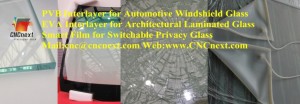Smart Glass Film:
How to make smart glass:
CNC-Smart Glass Film
80℃ Celsius Degrees Low Temperature Processing EVA Film for Laminating PDLC FILM(Smart Glass Film, Privacy Film, Magic Film, LED Film)
www.SmartestGlass.com www.EVAfilm.com
+80℃ Celsius Degrees Low Temperature Processing
–Because of our patented modification of EVA Film formula, the CNC4SG EVA Film can activate the cross-link reaction at 80℃ Celsius Degrees. Due to this low temperature laminating advantage, when laminating smart glass with CNC4SG EVA FILM, the smart PDLC film is only in the 80℃ Celsius Degrees environment and so can be protected from too high temperature(other EVA film needs 130℃ to activate cross-link reaction.)
+Bubbles Problem:
–High bubbles possibility-With Smart Glass Film sandwiched inside two glasses, the Pre-Laminated Smart Glass is easier to get bubbles than just laminating two glasses only. This problem has troubled the Smart Glass manufacturer very much for long time, because Smart Glass Film is high cost, they can not burden the cost of failure of laminating processing.
+Bubbles Solutions:
–Advantage 1: Higher Melt-Flow-Rate. The main way we do is that we specially modify a type of EVA Film for Smart Glass Lamination: CNC-Force-4SG EVA, which is specially higher in Melt-Flow-Rate to make the melting EVA Film can fill the glass and smart film surface more easily and sufficiently to reduce the chance of bubbles. Less bubbles means higher yield rate. High yield rate means cost reduction of your lines.
–Advantage 2: Lower Viscosity. Second, we modify the Viscosity of EVA Film to make the Melting EVA Film can go through and fill the glass and smart glass film surface concave-convex more easily and sufficiently to reduce the chance of bubbles. Less bubbles means higher yield rate. High yield rate means cost reduction of your lines.
(Laminar shear of fluid between two plates. Friction between the fluid and the moving boundaries causes the fluid to shear. The force required for this action is a measure of the fluid’s viscosity. )
–Advantage 3: Dust-Free. The other advantage of CNC-Force-4SG EVA is that the EVA Film is produced with MOST care of dust-free, no contamination and cleanness.We specially pay highest attention to the producing and package of CNC-Force-4SG EVA to make sure the EVA Film is very clean and away from dust and contamination. Lest contamination means higher yield rate. High yield rate means cost reduction of your lines.
All rights reserved by CNC-INTERLAYER TECH:
【Product 1】CNC-Force® EVA INERLAYER FOR ARCHITECTURAL LAMINATED GLASS
【Product 2】CNC-Smart® SMART FILM FOR PRIVACY SWITCHABLE GLASS
Web: www.CNCnext.com
Mail: [email protected]
[email protected]/
[email protected]
Delamination Analysis of Laminated Glass with Polyvinyl Butyral PVB Interlayer Film

Condition One: Delamination Appears in Lines
Reason:
When combining the glass with the Polyvinyl Butyral PVB interlayer film, some folds occur , or some place of Polyvinyl Butyral PVB interlayer film is too thin due to the hard pulling of the Polyvinyl Butyral PVB interlayer film. Especially the place near the hole or edges, some Polyvinyl Butyral PVB interlayer film have been shrink, so the Polyvinyl Butyral PVB interlayer film is too thin or even gone between the too glasses.
Solution:
When combining the glass with Polyvinyl Butyral PVB interlayer film, pull the Polyvinyl Butyral PVB interlayer film gently, make sure no fold of Polyvinyl Butyral PVB interlayer film, and the Polyvinyl Butyral PVB interlayer film is 2mm wider than the glass. And also cut the Polyvinyl Butyral PVB interlayer film gently.
Condition Two: Delamination in Edges and Holes of Laminated Glass with Polyvinyl Butyral PVB Interlayer Film
Reason:
The plainness of the edges and holes of the tempered glass is not good.
Solution:
Adjust the plainness of the tempered glass, clip the edges of the pre-laminated glass before putted into the autoclave. But don’t use too big clips, in case the PVB Film’s shape changes.
Condition Three: Delamination on Edges and Holes After the Laminated Glass is Installed in the Building
Solution: Install the laminated glass gently. it’s better if use the wrench with scale to hole the laminated glass. Make sure the glass glue is suitable for the laminated glass, and it should be neutral glue.
Condition Four: Irregular Delamination of Laminated Glass with Polyvinyl Butyral PVB Interlayer Film
Reason1:
The Adhesion of Polyvinyl Butyral PVB interlayer film and glass is not strong.
Solution1:
The washing glass water is not good quality, it’s better use the water whose electric conductivity is lower than 20us.
Solution2:
The Polyvinyl Butyral PVB interlayer film absorbed too much moisture, maybe more than 6%. If moisture of Polyvinyl Butyral PVB interlayer film is higher than 1%, the laminated glass may appear white haze.
Solution3:
The combination of pre-laminated glass and roller exhausting air stage maybe not operate correctly, which lead to Polyvinyl Butyral PVB interlayer film not reacted perfectly. The main parameters are temperature, pressure and time.
Solution4:
The glass surface is not clean and dry enough.
Reason2:
The Polyvinyl Butyral PVB interlayer film is too thin.
Solution:
Use thicker or more layer of Polyvinyl Butyral PVB interlayer film.
Reason3:
The plainness of the tempered glass is not good.
Solution: Choose better quality tempered glass.
Condition Five: Delamination of Laminated Glass with Polyvinyl Butyral PVB Interlayer Film When in Boling Water Test
Reason1:
Two much air contained inside the laminated glass with Polyvinyl Butyral PVB interlayer film.
Solution1:
Sealing the edges too early in the pre-pressure exhausting air stage, which lead to the air stocked inside the laminated glass. Although, it seams successful when the laminated glass come out from the autoclave, but when in the boiling test, the bubbles will appears.
Reason2:
The Polyvinyl Butyral PVB interlayer film has absorbed too much moisture before laminating.
Solution2:
Adjust the storage conditions, make sure the moisture of Polyvinyl Butyral PVB interlayer film is less than 0.55%.
Copyright:

All rights reserved by CNC-INTERLAYER TECH:
【1】CNC-Force® EVA INERLAYER FOR ARCHITECTURAL LAMINATED GLASS
【2】CNC-Smart® SMART FILM FOR PRIVACY SWITCHABLE GLASS
【3】CNC-Shield® PVB INTERLAYER FOR AUTOMOTIVE WINDSHIELD GLASS
Mail: [email protected]
Web: www.CNCnext.com
[email protected]/
[email protected]